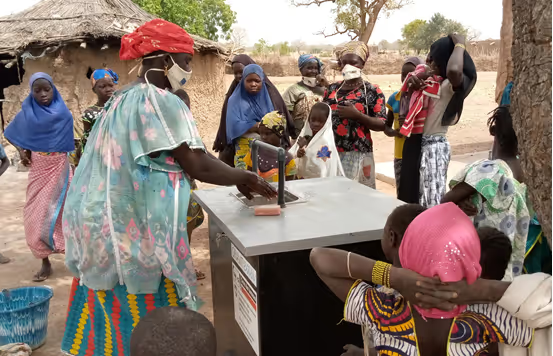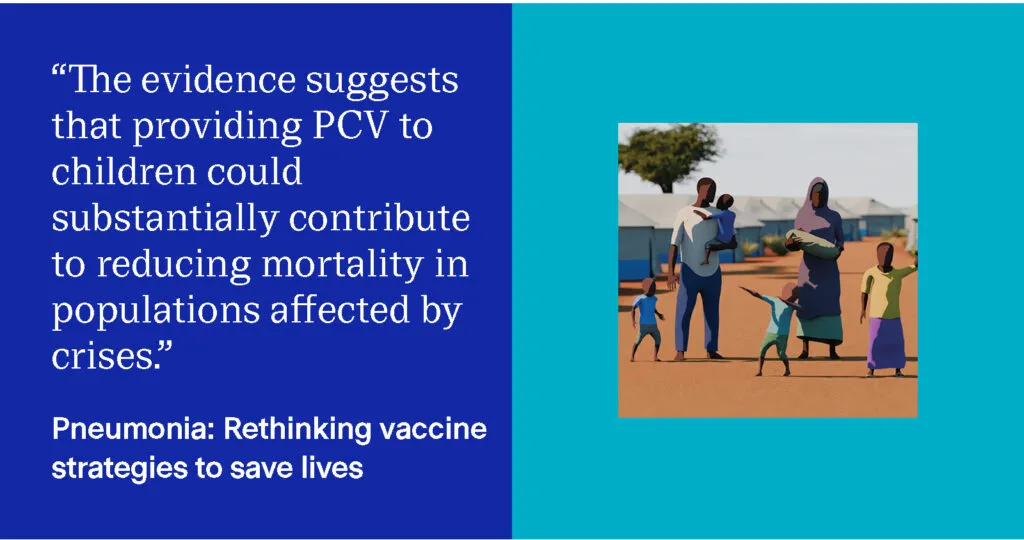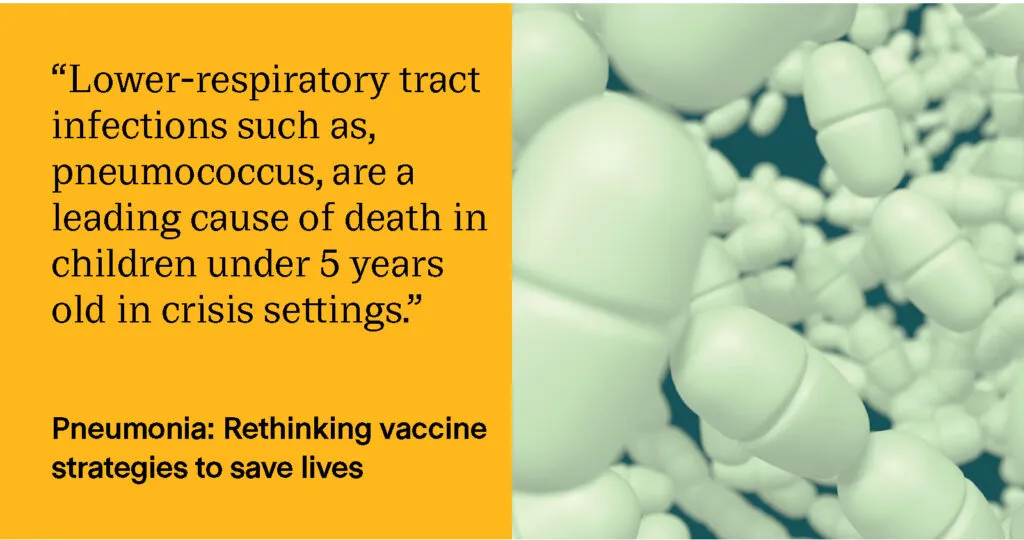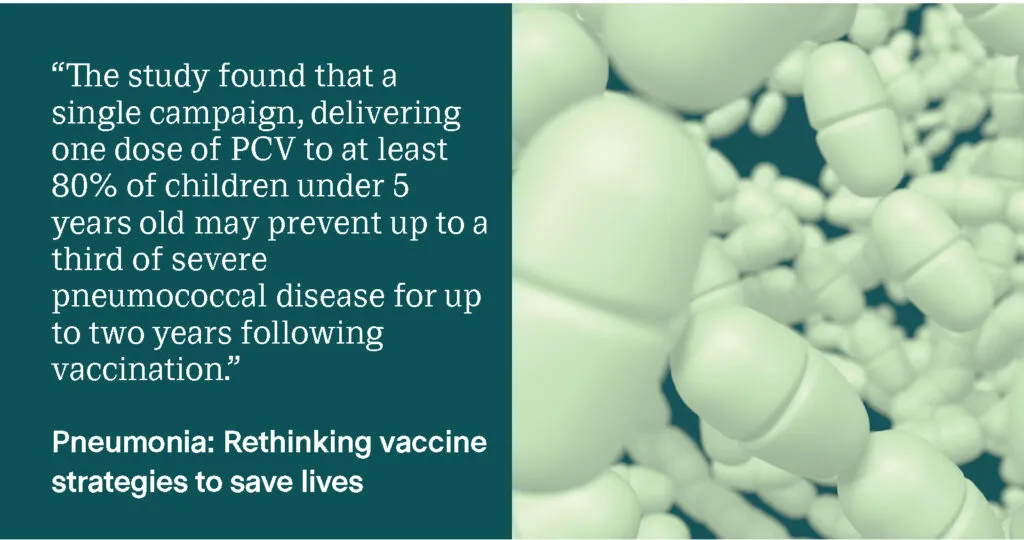Pneumococcal vaccination strategies for crisis affected populations

Project overview
This study aimed to identify effective and cost-effective pneumococcal vaccination strategies for crisis affected populations.
Countries
Somalia
South Sudan
Organisations
London School of Hygiene and Tropical Medicine
Save the Children
Murdoch Children's Research Institute
Ministry of Health Somaliland
Partners
Médecins Sans Frontières UK/Operational Centre Amsterdam, Save the Children UK, Murdoch Children's Research Institute
Area of funding
Humanitarian Research
Grant amount
£356,947
Start date
01
September
2018
End date
01
April
2025
Project length (in months)
79
Funding calls
Focus areas
Topics
No items found.
Status
Live
Project solution
This project offers [specific solution or intervention] to tackle [challenge]. By implementing [strategies, tools, or innovations], the project aims to achieve [desired outcomes]. The approach is designed to [specific actions or methods] to bring about meaningful change in [community, region, or issue area].
Expected outcomes
This project aims to achieve [specific outcomes], such as [measurable results, improvements, or changes]. The expected impact includes [benefits to the target community, advancements in research or innovation, or long-term effects]. By the end of the project, we anticipate [specific changes or milestones] that will contribute to [broader goals or objectives].
No items found.
Principal Investigators: Stefan Flasche, LSHTM & Francesco Checci, LSHTM
[.slimline-cta-box][.slimline-cta_heading]Research Snapshot: Effective pneumococcal vaccination campaigns in displaced populations[.slimline-cta_heading][.slimline-cta_paragraph]Generating evidence on optimal vaccination strategies to protect children in humanitarian settings against pneumococcal pneumonia.[.slimline-cta_paragraph][.slimline-cta_paragraph]Read the Research Snapshot[.slimline-cta_paragraph][.slimline-cta-box]
What did the study set out to achieve?
This study aimed to identify effective and cost-effective pneumococcal vaccination strategies for crisis affected populations. Specifically to:
- Identify optimal mass pneumococcal vaccination strategies that reduce disease burden in displacement, rural and urban crisis scenarios;
- Estimate the cost and cost-effectiveness of these strategies; and
- Quantify the global theoretical pneumococcal vaccine need for humanitarian uses.
The project expected to produce recommendations on optimal pneumococcal vaccination strategies as well as:
- A unique quantification of social mixing and nasopharyngeal carriage patterns in a displaced, overcrowded population, providing a basis for further work on disease control strategies in such populations, including for other pathogens;
- A readily transferable, general model to estimate pneumococcal carriage, disease burden and the potential benefit of vaccination in other crisis settings, helping to tailor strategies and prioritisation decisions to specific contexts.
What were the key findings?
Based on data collected from 509 participants across 464 households (65% of inhabited unique shelters) and 454 swabs, the study found:
- A high prevalence of risk factors for respiratory illness (e.g. crowded living conditions; 20% of children under five years of age were stunted)
- A high disease burden: 46% of children with self-reported recent pneumonia, high crude death rates, and carriage rates similar to those of rural Kenya.
- Vaccination of children under one year of age only has limited and short-lived effects.
- Vaccination of children under five years of age at high coverage can
- prevent about 30% of severe pneumococcal disease in the 2 years following the campaign
- partially protect unvaccinated infants for 3-5 years after the campaign due to reduced transmission
- Vaccination of under fives is also cost effective: it prevents a similar amount of disease per dose administered as routine use in infants in Kenya.
- If migration rates are high or vaccine coverage is low, extending campaigns to older children can retain indirect protection.
What are the implications for practitioners and policymakers?
These findings imply that humanitarian actors should consider integrating pneumococcal conjugate vaccine campaigns for at least <5-yearold children into their routine humanitarian response portfolio.
This could be done through co-administration with measles containing vaccines and Vitamin A in the acute phase of a humanitarian crisis.
To have the most impact, a PCV campaign should target not only the children most at risk of severe disease (those under two) but also key transmitters (mainly older children aged two to 10). Campaigns limited to only children most at risk are less effective and less efficient in offering durable protection.
Through an R2HC uptake grant, the study team created a video summarising key messages for stakeholders to influence the guidance for PCV vaccination in humanitarian settings. Notably, the study findings were presented to the WHO SAGE committee in March 2025 with the meeting report including that multi-age cohort campaigns (MAC) with a single dose of PCV should be considered in crises settings to achieve population immunity rapidly. This informed the WHO's September 2025 position paper on Pneumococcus which includes a statement on MAC campaigns in humanitarian emergencies.
No items found.
Project delivery & updates
Stay up to date with the latest developments from this project. Here, you will find details on what has been delivered, resources created, and regular updates as the project progresses. Access key documents, reports, and other materials to see how the project is making an impact.
No resources/updates have been published yet for this project. Sign up for our newsletter to stay informed about upcoming publications and updates!
Join our Newsletter
Resources
Research Snapshot: Effective pneumococcal vaccination campaigns in displaced populations
Research snapshot
LEARN MOREPre-vaccination carriage prevalence of Streptococcus pneumoniae serotypes among internally displaced people in Somaliland
Journal article
LEARN MORESocial contacts and other risk factors for respiratory infections among internally displaced people in Somaliland
Journal article
LEARN MORELatest updates
No items found.


